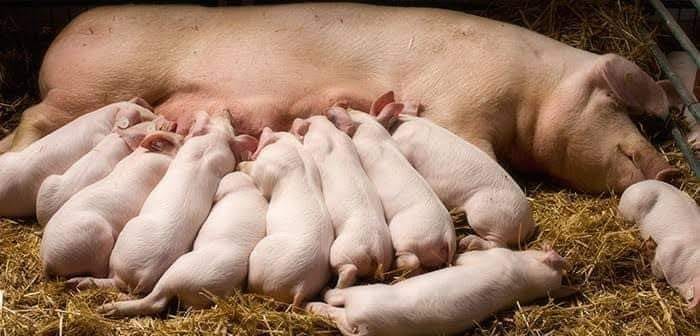By Christopher Mulindwa
The most common question I get from people thinking of investing in pigs is; “What do I need to know before starting a pig farming business?” This isn’t an easy question but for us to find right answers, we will need to go through the whole process.
ALSO READ:
GUIDE: What To Consider When Starting UP A Commercial Pig Farming Business (PART 1)
GUIDE: What To Consider When Starting UP A Commercial Pig Farming Business (PART II)
First you have to look at resources available and the main product you want to put on market.
This may be:
1. Selling pigs for breeding
2. Selling pigs for slaughter/Pork carcasses
3. Or both.
The products apply to all sizes of production; Small, Medium and Large scale.
SMALL & MEDIUM SCALE PRODUCERS:
Due to the fact that Pig farming in Uganda and most African countries is just developing, small and medium scale producers own it. However this cannot be permanent in societies where small and medium scale producers fail to organize themselves and focus on building a competitive advantage. Soon or later, they are taken up by industry farms.

This is the case for South Africa today, many small farms have closed and medium scale farms bought by large farms because they can no longer compete with them in terms of quality consistency, cost of production, pricing etc.
In every developing pig industry, about four production types exists:
1. Wean to market
2. Wean to finish
3. A combination of 1 & 2
4. Fatten to market
The above defines the product you put on market. Understanding where you belong is very important for planning farm activities, choosing breeds and identifying market channels for your product. I will therefore discuss each in detail.
WEAN TO MARKET:
The producer owns sow (s) . All piglets produced are sold to other farmers and the cycle continues.
This is the most common production type practiced in Uganda and until today many producers are investing in it. Almost all small and medium scale pig producers in Uganda produce piglets for sale. Piglets are sold at between 1 and 2 Months weighing about 4 to 8 kilograms.
Surprisingly, even development projects including those by government and non government organizations support farmers to invest in the same production type! This production type has failed many farmers and still failing more! Why?
1. A piglet is very sensitive so requires specialized feeds and a good knowledge of management to prevent it from stunting or even death. Giving it to a novice means loss of life and if survived, they never grow well. Creep feed is either not introduced earlier enough or not given at all.
2. A pig for breeding can’t be selected at very young age. At this stage you have a limited record on both feed conversion, average daily gain etc. A breeding pig is best selected at between 5 and 7 Months of age.
3. There are higher chances of inbreeding. This is because everybody is a breeder and no unique source for grandparents. Traceability too is very difficult due to limited identification and recording. This leads to reduced performance.
4. When every body is producing and selling piglets, the market is easily saturated. This either lead to reduced price per piglet or quantity sold to as low as zero.
5. It suppresses superiority of new breeds in the country due to uncontrollable inbreeding and unplanned crossbreeding. The easiest example is Combrough. A good mother breed line turned into no sense. It will take PIC sometime and effort to rebuild its reputation and etc.
6. There is limited effort towards supplying the pork market with enough quality pigs. Only sick, won out and non productive pigs goes to the pork market.
I understand many small and medium scale producers prefer starting with 1 – 2 Months old piglets because they are cheaper to buy. However besides spending little at a time on their feeding etc as they grow, buying piglets is even more expensive due to the risks involved.
The idea of buying piglets should be reserved for inevitable circumstances like importation and where transporting mature animals is hugely expensive or risky. However, there must be a proper management plan to enable them grow well.
In Uganda, the most frustrated pig farmers are medium scale producers adopting this production type. Unfortunately, they are the majority!
The challenge with selling piglets; the main buyers are fellow farmers who are either replacing won out/sold stock, improving farm breeds or starting pig farming business. The most frequent buyers are smallholders who buy one to two piglets. The medium scale producer can afford five to 10 and large producers basing on Uganda standards may buy more than 10 piglets. Also, this market is once in a while supplemented by development projects from government and non government organizations. These buy huge numbers of piglets for distribution to their beneficiaries.
In Uganda, most piglets are sold after key festive seasons. Most pigs are eaten during Christmas and new year’s celebrations. Therefore the Piglet market is big in February & March. Also after martyrs day and Easter celebrations farmers will be restocking so piglet market is available. There is also a celebration in the middle that I don’t want to mention, it also largely influence pork consumption therefore the piglet market. What makes this frustrating is the difficulty by small and medium scale pig producers to manage farrowing cycles so that piglets are born only during these periods when market is available. Things just happen! Therefore many farmers just find themselves with piglets but no buyer. They are therefore forced into unplanned fattening ending up growing a 30Kg carcass of pork for more than 7 months! Absolutely, this is a loss.
For this production type to work, there must be a deliberate effort towards understanding the main objective of farming pigs. Pigs are food animals and are farmed for pork. If we farm pigs to produce piglets as a key objective, we loose focus. The business is Pork and that is where our main focus must be. It is even better to call ourselves Pork producers other than pig producers !
Also those producing pigs for either other farmers to breed or fatten must carry a similar mindset. Except for pets, all pigs must be looked at as Pork.
Some farmers can sale breeding pigs or young pigs (25 to 30 kilograms body weight) for fattening and others fatten them to supply the pork market. I say this without considering farm size. We don’t necessarily have to do it the European or American way but our own profitable and manageable way. This creates a sustainable cycle, the piglets producer will have market because as the one fattening sales, he returns to buy more pigs for his next fatting cycle.
I as well urge government and non government organizations to start thinking within this line if truly committed to improving farm incomes and promoting pig farming. We should work hard towards streamlining our production systems. There must be a definable process through which a piglet is born and grown until on consumer’s plate.
We can’t keep complaining about lower prices and an unreliable marketing system yet quality and quantities are still wanting. Anyway, what more do you want for pork carcass from a 2 year old boar, a 10 parity sow and 12 Months old fatteners whose carcasses weigh only 30 kilograms! We need to commit ourselves to producing products acceptable by at-least more than a Marketing channel. Products acceptable by premium markets, export etc.
After streamlining the system, then we think of the breeds to adopt. Of course you can’t just think about acquiring top quality genetics straight away. The best thing to do now is to define a process through which breeds available can be upgraded to something better.
Wean to market production type requires you to think about both people buying your pigs for fattening and the consumers of meat from your pigs. Remember if the meat doesn’t meet consumer requirements, the business will collapse. Therefore, weaning to market requires some smartness and innovation.
Someone buying from you to fatten will need quick maturing, disease resistant, high carcass quality and adoptable pigs. The consumer needs more muscle and less fat, a good and consistent taste, meat safe for human consumption etc. I think we now understand that weaning to market is more than just buying a female and male pig if you are to make profit from it sustainably!
To succeed in the wean to market business:
1. Educate yourself about basic principles of pig breeding and ensure you are engaging in something well understood.
2. Avoid selling very young piglets rest you kill your reputation. When people buy small pigs and later fail on looking after them, they complain about the breed. They will think that whatever you sold to them was of poor quality breed. It is better to sale piglets weighing 25 kilograms and above. Training or instructing buyers on how to look after these piglets is very important.
3. You must be able to assure buyers of disease free pigs. If you can’t then every health problem that happens to the buyer will be blamed on you. Farm visitations must be highly restricted, dogs must be kept in farm fence always, health records must be available, there must be a routine health check, new and sick pigs on farm must be quarantined etc. Your actions towards farm health must convince the buyer beyond any reasonable doubt that you operate a disease free farm.
4. Teach your customers to upgrade farm genetics gradually as your genetic base grows. It doesn’t make sense waking up and rise prices of your pigs by 50% because you imported new genetics. Sometimes, the market may not quickly appreciate and pay a premium for pork produced. This affects your customers’ business and they may decide to find other alternatives. Sustainable genetics upgrade must happen gradually as the market appreciates the benefit. The pig sector here can’t be like that of South Africa, America or Europe in a month or even a year. So think about where you are and how to move to your destiny.
5. Embrace Artificial Insemination. This is the only easiest and cheapest way for grading up farm genetics. Every offspring is 50% the quality of the boar used. You can even create your own purebred base through repeated upgrade. Between four to five offsprings gets you there. The advantage of such a process is that adaptability to both new climatic conditions, disease threat, management procedures is developed gradually. Also your experience in managing and breeding top quality genetics improves.
I request you to understand that the benefits of an improved system in Wean to Market production type might not be unlocked immediately. It will develop as more people change their behavior and approaches towards pig farming. However, you are one of these people so it starts with you.
Lastly, you cannot manage such a business profitably without a performing and affordable feeding strategy. The Nuscience concetrates including the Pig 25% and 5% are the best feeding options for any body farming pigs for commercial purposes. Small and medium holder pig producers are advised to start with the pig 25% concetrate as they lay strategies to source for quality Soybean and Sunflower. They can thereafter change to the pig 5% concetrate if necessary.
My book Farming Pigs For Money is available from Aristoc and Uganda Bookshop. If you want it delivered to you, WhatsApp +256 773 422 445. The book cost 25000/-.





Nice article . Gives a deeper insight into pig farming businesses in Uganda.
Thanks.